ITECH7409 - Software Testing Standard Report: A Comprehensive Overview
VerifiedAdded on 2023/01/23
|8
|1715
|84
Report
AI Summary
This report examines the ISO/IEC/IEEE 29119 software testing standard, an internationally recognized set of standards designed to ensure software quality across various development methodologies. The report begins by defining the standard and its purpose, highlighting its role in establishing a common language and set of procedures for software testing. It then delves into the standard's scope, which includes defining processes at the test management, organizational, and dynamic test levels, as well as supporting diverse testing approaches such as functional, non-functional, automated, and manual tests. The report explores the key parts of the standard, including ISO/IEC/IEEE 29119-1 (Concepts and Definitions), 29119-2 (Test Process), 29119-3 (Test Documentation), 29119-4 (Test Techniques), and 29119-5 (Keyword Driven Test). Furthermore, the report discusses the relevance of the standard in software testing, emphasizing its importance for establishing consistency, defining roles, and providing a framework for testers. The report also includes a discussion of a related research paper, analyzing the standard's components and limitations. In conclusion, the report emphasizes the value of adopting this standard in software development and its significance for software testers and the broader testing community.
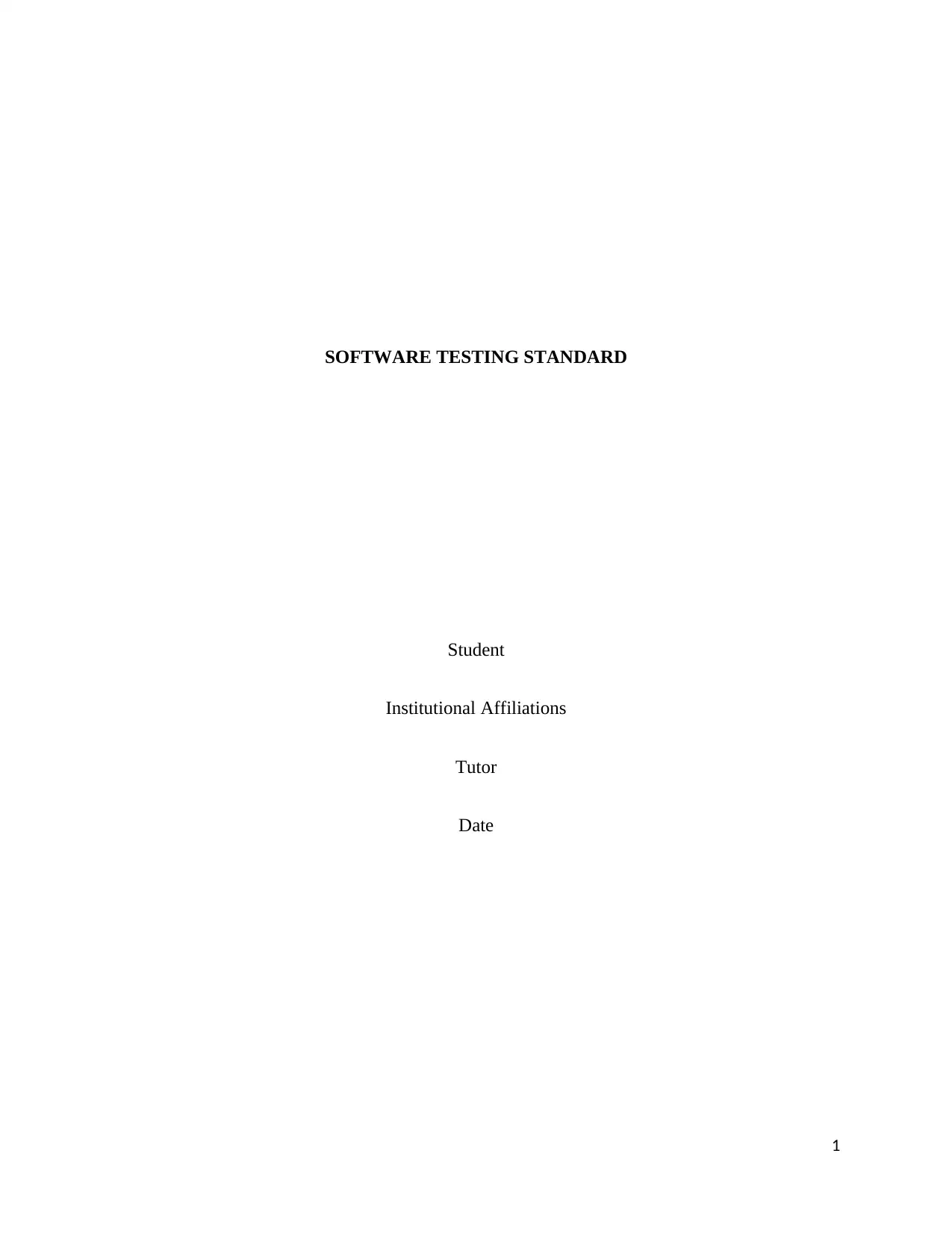
SOFTWARE TESTING STANDARD
Student
Institutional Affiliations
Tutor
Date
1
Student
Institutional Affiliations
Tutor
Date
1
Paraphrase This Document
Need a fresh take? Get an instant paraphrase of this document with our AI Paraphraser
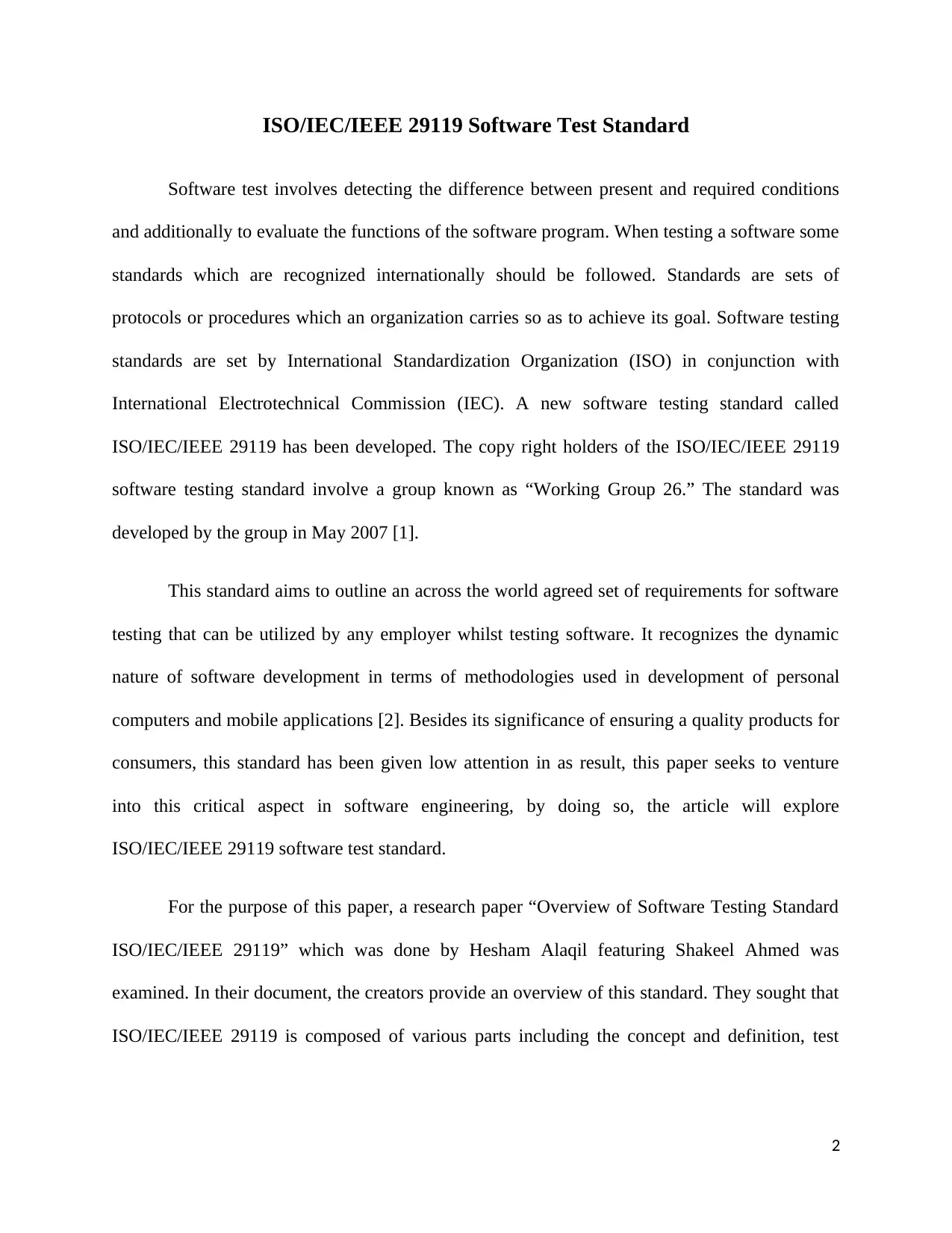
ISO/IEC/IEEE 29119 Software Test Standard
Software test involves detecting the difference between present and required conditions
and additionally to evaluate the functions of the software program. When testing a software some
standards which are recognized internationally should be followed. Standards are sets of
protocols or procedures which an organization carries so as to achieve its goal. Software testing
standards are set by International Standardization Organization (ISO) in conjunction with
International Electrotechnical Commission (IEC). A new software testing standard called
ISO/IEC/IEEE 29119 has been developed. The copy right holders of the ISO/IEC/IEEE 29119
software testing standard involve a group known as “Working Group 26.” The standard was
developed by the group in May 2007 [1].
This standard aims to outline an across the world agreed set of requirements for software
testing that can be utilized by any employer whilst testing software. It recognizes the dynamic
nature of software development in terms of methodologies used in development of personal
computers and mobile applications [2]. Besides its significance of ensuring a quality products for
consumers, this standard has been given low attention in as result, this paper seeks to venture
into this critical aspect in software engineering, by doing so, the article will explore
ISO/IEC/IEEE 29119 software test standard.
For the purpose of this paper, a research paper “Overview of Software Testing Standard
ISO/IEC/IEEE 29119” which was done by Hesham Alaqil featuring Shakeel Ahmed was
examined. In their document, the creators provide an overview of this standard. They sought that
ISO/IEC/IEEE 29119 is composed of various parts including the concept and definition, test
2
Software test involves detecting the difference between present and required conditions
and additionally to evaluate the functions of the software program. When testing a software some
standards which are recognized internationally should be followed. Standards are sets of
protocols or procedures which an organization carries so as to achieve its goal. Software testing
standards are set by International Standardization Organization (ISO) in conjunction with
International Electrotechnical Commission (IEC). A new software testing standard called
ISO/IEC/IEEE 29119 has been developed. The copy right holders of the ISO/IEC/IEEE 29119
software testing standard involve a group known as “Working Group 26.” The standard was
developed by the group in May 2007 [1].
This standard aims to outline an across the world agreed set of requirements for software
testing that can be utilized by any employer whilst testing software. It recognizes the dynamic
nature of software development in terms of methodologies used in development of personal
computers and mobile applications [2]. Besides its significance of ensuring a quality products for
consumers, this standard has been given low attention in as result, this paper seeks to venture
into this critical aspect in software engineering, by doing so, the article will explore
ISO/IEC/IEEE 29119 software test standard.
For the purpose of this paper, a research paper “Overview of Software Testing Standard
ISO/IEC/IEEE 29119” which was done by Hesham Alaqil featuring Shakeel Ahmed was
examined. In their document, the creators provide an overview of this standard. They sought that
ISO/IEC/IEEE 29119 is composed of various parts including the concept and definition, test
2
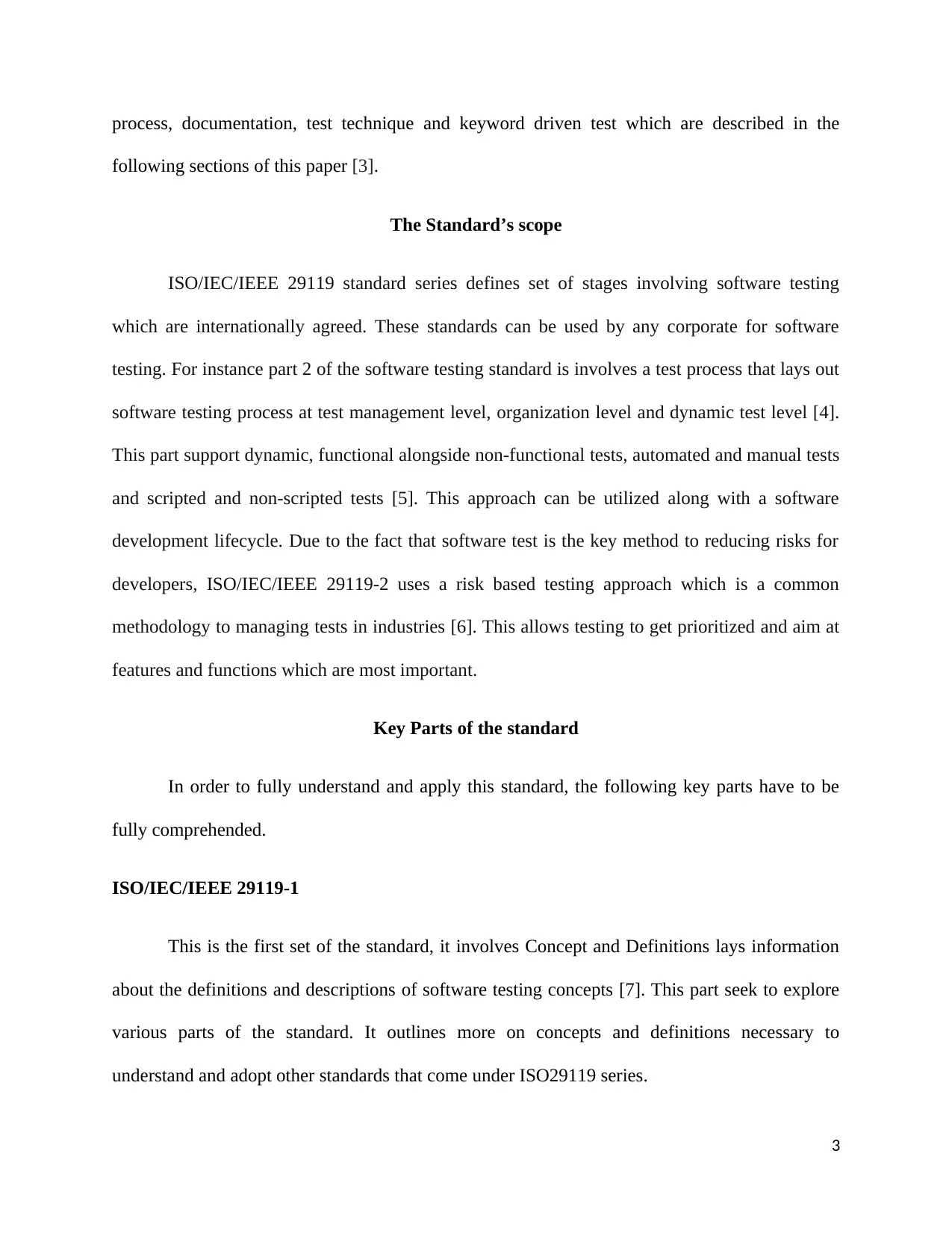
process, documentation, test technique and keyword driven test which are described in the
following sections of this paper [3].
The Standard’s scope
ISO/IEC/IEEE 29119 standard series defines set of stages involving software testing
which are internationally agreed. These standards can be used by any corporate for software
testing. For instance part 2 of the software testing standard is involves a test process that lays out
software testing process at test management level, organization level and dynamic test level [4].
This part support dynamic, functional alongside non-functional tests, automated and manual tests
and scripted and non-scripted tests [5]. This approach can be utilized along with a software
development lifecycle. Due to the fact that software test is the key method to reducing risks for
developers, ISO/IEC/IEEE 29119-2 uses a risk based testing approach which is a common
methodology to managing tests in industries [6]. This allows testing to get prioritized and aim at
features and functions which are most important.
Key Parts of the standard
In order to fully understand and apply this standard, the following key parts have to be
fully comprehended.
ISO/IEC/IEEE 29119-1
This is the first set of the standard, it involves Concept and Definitions lays information
about the definitions and descriptions of software testing concepts [7]. This part seek to explore
various parts of the standard. It outlines more on concepts and definitions necessary to
understand and adopt other standards that come under ISO29119 series.
3
following sections of this paper [3].
The Standard’s scope
ISO/IEC/IEEE 29119 standard series defines set of stages involving software testing
which are internationally agreed. These standards can be used by any corporate for software
testing. For instance part 2 of the software testing standard is involves a test process that lays out
software testing process at test management level, organization level and dynamic test level [4].
This part support dynamic, functional alongside non-functional tests, automated and manual tests
and scripted and non-scripted tests [5]. This approach can be utilized along with a software
development lifecycle. Due to the fact that software test is the key method to reducing risks for
developers, ISO/IEC/IEEE 29119-2 uses a risk based testing approach which is a common
methodology to managing tests in industries [6]. This allows testing to get prioritized and aim at
features and functions which are most important.
Key Parts of the standard
In order to fully understand and apply this standard, the following key parts have to be
fully comprehended.
ISO/IEC/IEEE 29119-1
This is the first set of the standard, it involves Concept and Definitions lays information
about the definitions and descriptions of software testing concepts [7]. This part seek to explore
various parts of the standard. It outlines more on concepts and definitions necessary to
understand and adopt other standards that come under ISO29119 series.
3
⊘ This is a preview!⊘
Do you want full access?
Subscribe today to unlock all pages.

Trusted by 1+ million students worldwide
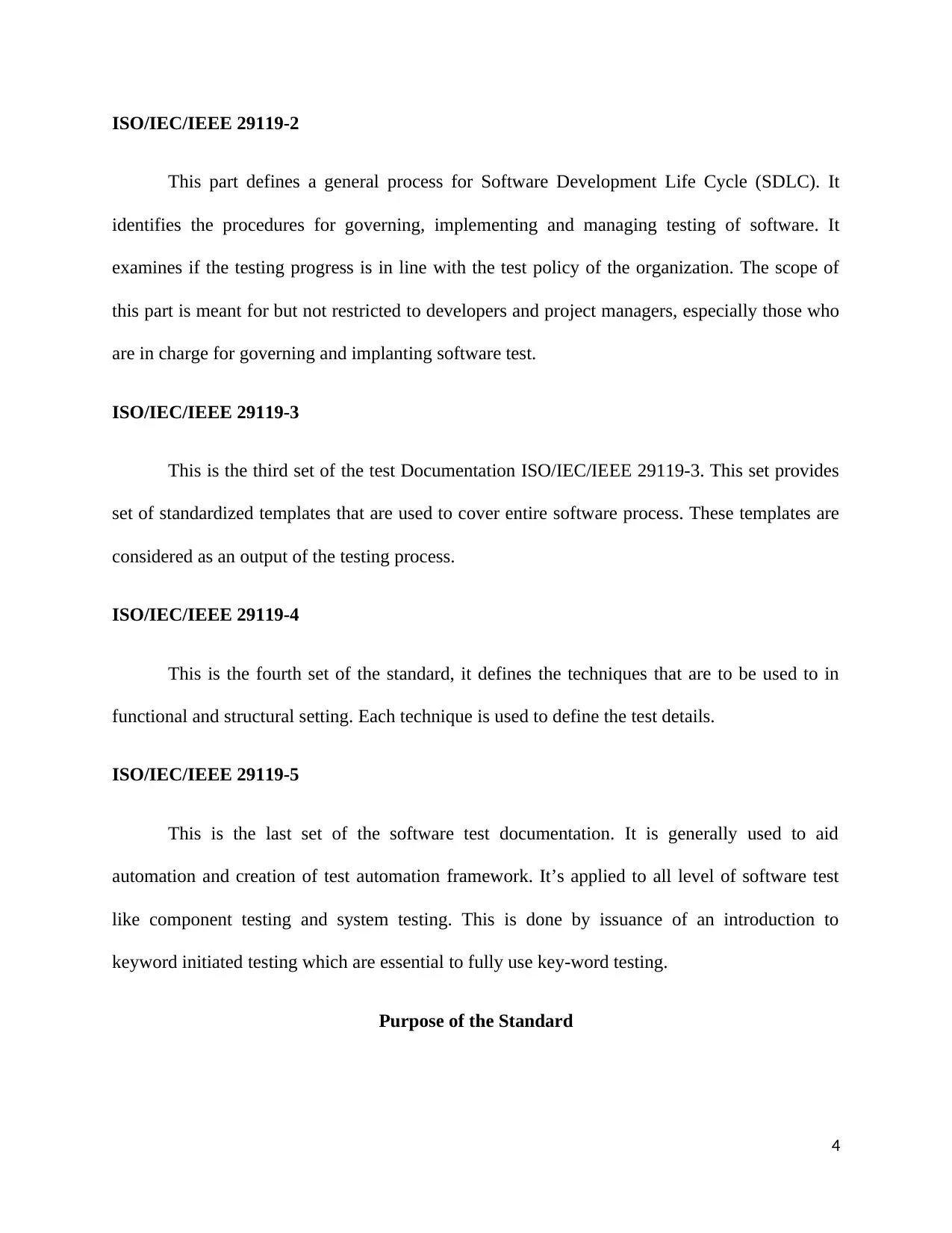
ISO/IEC/IEEE 29119-2
This part defines a general process for Software Development Life Cycle (SDLC). It
identifies the procedures for governing, implementing and managing testing of software. It
examines if the testing progress is in line with the test policy of the organization. The scope of
this part is meant for but not restricted to developers and project managers, especially those who
are in charge for governing and implanting software test.
ISO/IEC/IEEE 29119-3
This is the third set of the test Documentation ISO/IEC/IEEE 29119-3. This set provides
set of standardized templates that are used to cover entire software process. These templates are
considered as an output of the testing process.
ISO/IEC/IEEE 29119-4
This is the fourth set of the standard, it defines the techniques that are to be used to in
functional and structural setting. Each technique is used to define the test details.
ISO/IEC/IEEE 29119-5
This is the last set of the software test documentation. It is generally used to aid
automation and creation of test automation framework. It’s applied to all level of software test
like component testing and system testing. This is done by issuance of an introduction to
keyword initiated testing which are essential to fully use key-word testing.
Purpose of the Standard
4
This part defines a general process for Software Development Life Cycle (SDLC). It
identifies the procedures for governing, implementing and managing testing of software. It
examines if the testing progress is in line with the test policy of the organization. The scope of
this part is meant for but not restricted to developers and project managers, especially those who
are in charge for governing and implanting software test.
ISO/IEC/IEEE 29119-3
This is the third set of the test Documentation ISO/IEC/IEEE 29119-3. This set provides
set of standardized templates that are used to cover entire software process. These templates are
considered as an output of the testing process.
ISO/IEC/IEEE 29119-4
This is the fourth set of the standard, it defines the techniques that are to be used to in
functional and structural setting. Each technique is used to define the test details.
ISO/IEC/IEEE 29119-5
This is the last set of the software test documentation. It is generally used to aid
automation and creation of test automation framework. It’s applied to all level of software test
like component testing and system testing. This is done by issuance of an introduction to
keyword initiated testing which are essential to fully use key-word testing.
Purpose of the Standard
4
Paraphrase This Document
Need a fresh take? Get an instant paraphrase of this document with our AI Paraphraser
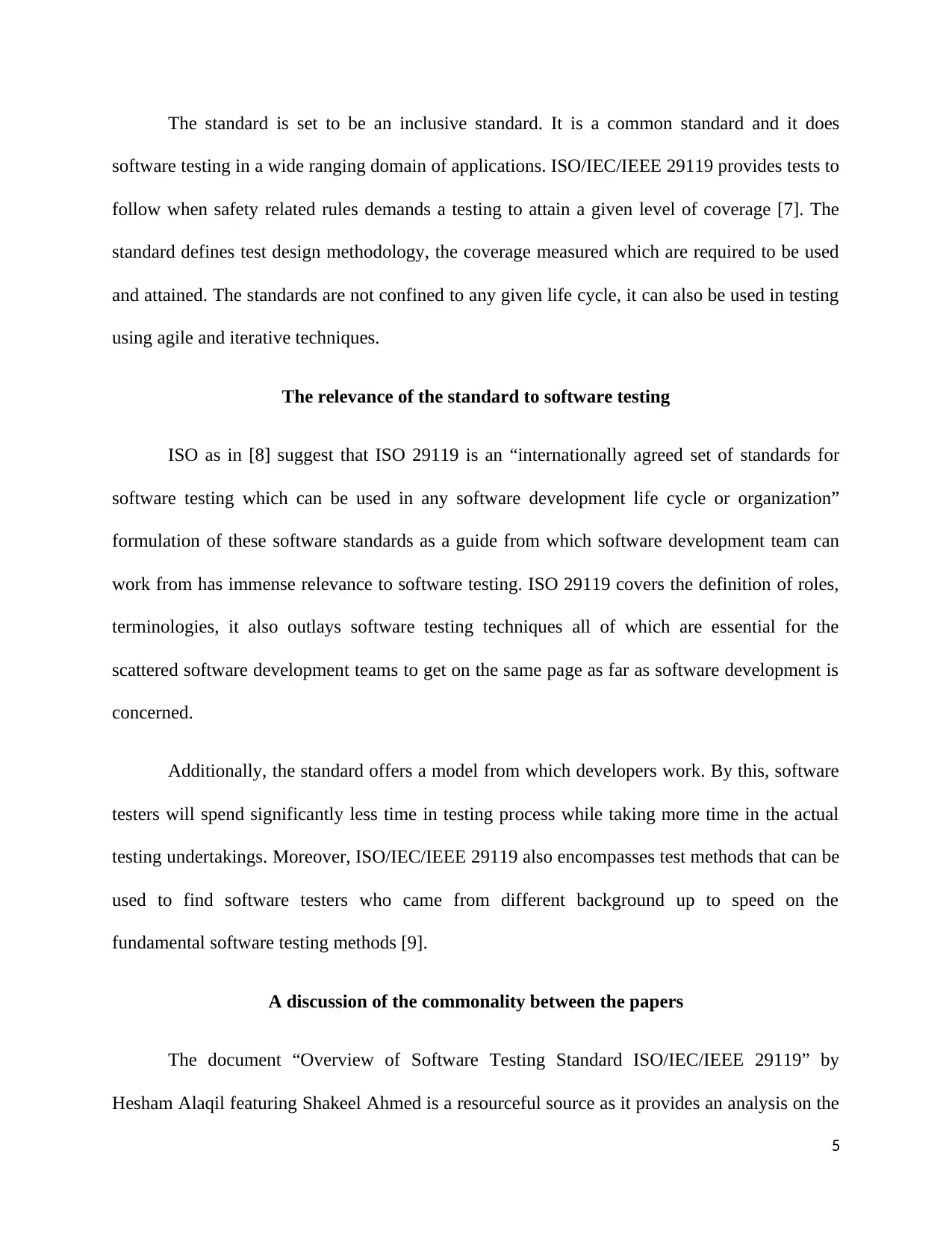
The standard is set to be an inclusive standard. It is a common standard and it does
software testing in a wide ranging domain of applications. ISO/IEC/IEEE 29119 provides tests to
follow when safety related rules demands a testing to attain a given level of coverage [7]. The
standard defines test design methodology, the coverage measured which are required to be used
and attained. The standards are not confined to any given life cycle, it can also be used in testing
using agile and iterative techniques.
The relevance of the standard to software testing
ISO as in [8] suggest that ISO 29119 is an “internationally agreed set of standards for
software testing which can be used in any software development life cycle or organization”
formulation of these software standards as a guide from which software development team can
work from has immense relevance to software testing. ISO 29119 covers the definition of roles,
terminologies, it also outlays software testing techniques all of which are essential for the
scattered software development teams to get on the same page as far as software development is
concerned.
Additionally, the standard offers a model from which developers work. By this, software
testers will spend significantly less time in testing process while taking more time in the actual
testing undertakings. Moreover, ISO/IEC/IEEE 29119 also encompasses test methods that can be
used to find software testers who came from different background up to speed on the
fundamental software testing methods [9].
A discussion of the commonality between the papers
The document “Overview of Software Testing Standard ISO/IEC/IEEE 29119” by
Hesham Alaqil featuring Shakeel Ahmed is a resourceful source as it provides an analysis on the
5
software testing in a wide ranging domain of applications. ISO/IEC/IEEE 29119 provides tests to
follow when safety related rules demands a testing to attain a given level of coverage [7]. The
standard defines test design methodology, the coverage measured which are required to be used
and attained. The standards are not confined to any given life cycle, it can also be used in testing
using agile and iterative techniques.
The relevance of the standard to software testing
ISO as in [8] suggest that ISO 29119 is an “internationally agreed set of standards for
software testing which can be used in any software development life cycle or organization”
formulation of these software standards as a guide from which software development team can
work from has immense relevance to software testing. ISO 29119 covers the definition of roles,
terminologies, it also outlays software testing techniques all of which are essential for the
scattered software development teams to get on the same page as far as software development is
concerned.
Additionally, the standard offers a model from which developers work. By this, software
testers will spend significantly less time in testing process while taking more time in the actual
testing undertakings. Moreover, ISO/IEC/IEEE 29119 also encompasses test methods that can be
used to find software testers who came from different background up to speed on the
fundamental software testing methods [9].
A discussion of the commonality between the papers
The document “Overview of Software Testing Standard ISO/IEC/IEEE 29119” by
Hesham Alaqil featuring Shakeel Ahmed is a resourceful source as it provides an analysis on the
5
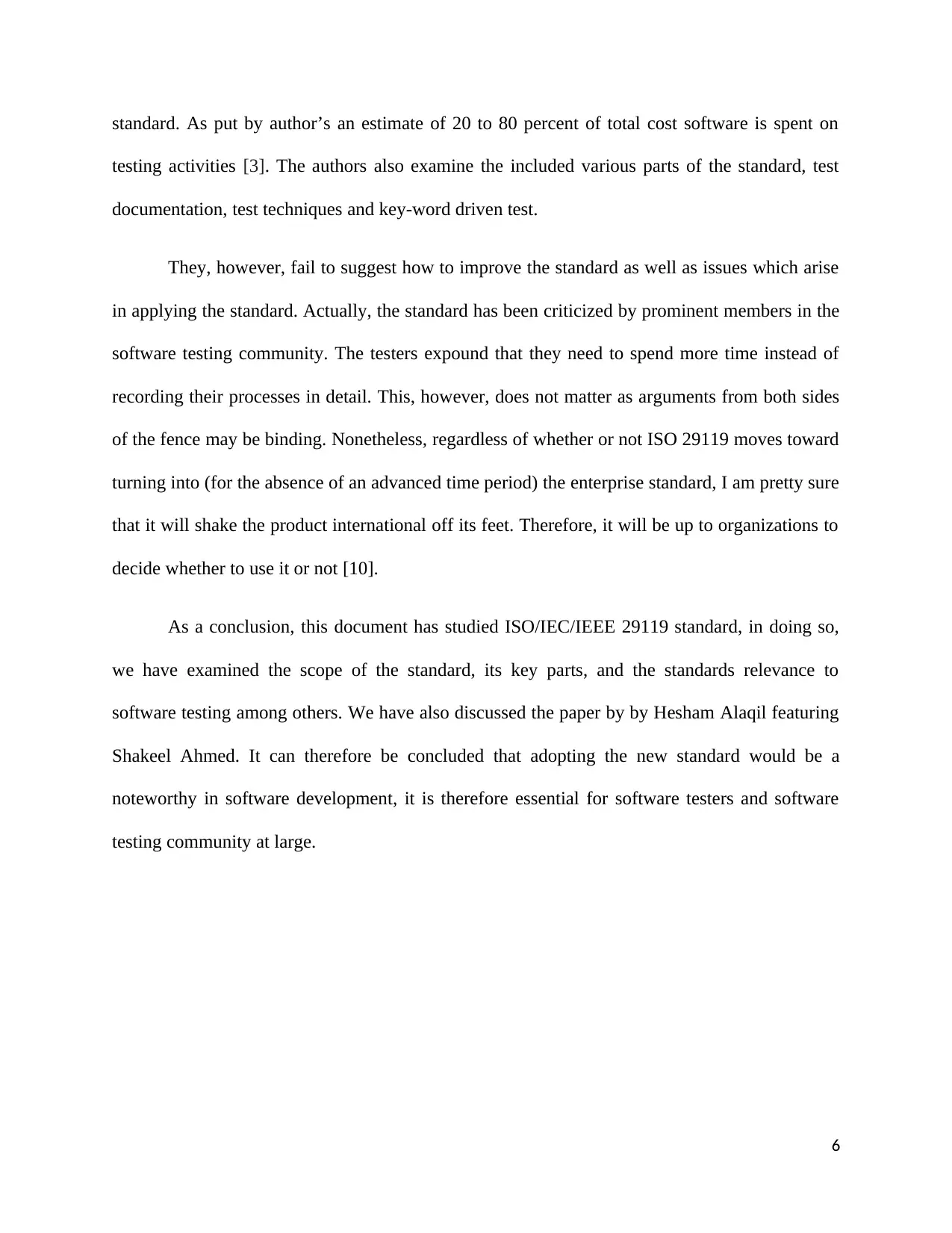
standard. As put by author’s an estimate of 20 to 80 percent of total cost software is spent on
testing activities [3]. The authors also examine the included various parts of the standard, test
documentation, test techniques and key-word driven test.
They, however, fail to suggest how to improve the standard as well as issues which arise
in applying the standard. Actually, the standard has been criticized by prominent members in the
software testing community. The testers expound that they need to spend more time instead of
recording their processes in detail. This, however, does not matter as arguments from both sides
of the fence may be binding. Nonetheless, regardless of whether or not ISO 29119 moves toward
turning into (for the absence of an advanced time period) the enterprise standard, I am pretty sure
that it will shake the product international off its feet. Therefore, it will be up to organizations to
decide whether to use it or not [10].
As a conclusion, this document has studied ISO/IEC/IEEE 29119 standard, in doing so,
we have examined the scope of the standard, its key parts, and the standards relevance to
software testing among others. We have also discussed the paper by by Hesham Alaqil featuring
Shakeel Ahmed. It can therefore be concluded that adopting the new standard would be a
noteworthy in software development, it is therefore essential for software testers and software
testing community at large.
6
testing activities [3]. The authors also examine the included various parts of the standard, test
documentation, test techniques and key-word driven test.
They, however, fail to suggest how to improve the standard as well as issues which arise
in applying the standard. Actually, the standard has been criticized by prominent members in the
software testing community. The testers expound that they need to spend more time instead of
recording their processes in detail. This, however, does not matter as arguments from both sides
of the fence may be binding. Nonetheless, regardless of whether or not ISO 29119 moves toward
turning into (for the absence of an advanced time period) the enterprise standard, I am pretty sure
that it will shake the product international off its feet. Therefore, it will be up to organizations to
decide whether to use it or not [10].
As a conclusion, this document has studied ISO/IEC/IEEE 29119 standard, in doing so,
we have examined the scope of the standard, its key parts, and the standards relevance to
software testing among others. We have also discussed the paper by by Hesham Alaqil featuring
Shakeel Ahmed. It can therefore be concluded that adopting the new standard would be a
noteworthy in software development, it is therefore essential for software testers and software
testing community at large.
6
⊘ This is a preview!⊘
Do you want full access?
Subscribe today to unlock all pages.

Trusted by 1+ million students worldwide
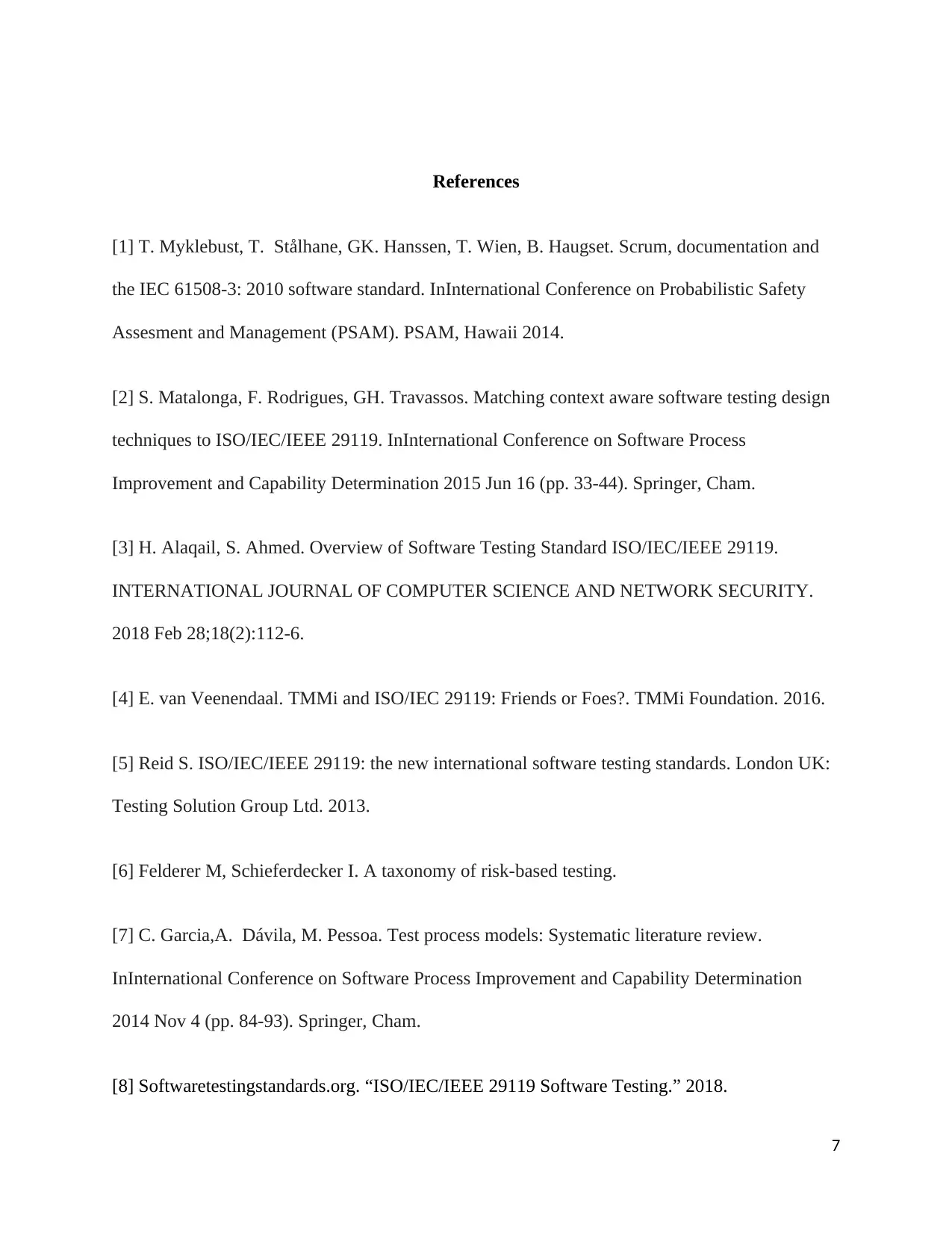
References
[1] T. Myklebust, T. Stålhane, GK. Hanssen, T. Wien, B. Haugset. Scrum, documentation and
the IEC 61508-3: 2010 software standard. InInternational Conference on Probabilistic Safety
Assesment and Management (PSAM). PSAM, Hawaii 2014.
[2] S. Matalonga, F. Rodrigues, GH. Travassos. Matching context aware software testing design
techniques to ISO/IEC/IEEE 29119. InInternational Conference on Software Process
Improvement and Capability Determination 2015 Jun 16 (pp. 33-44). Springer, Cham.
[3] H. Alaqail, S. Ahmed. Overview of Software Testing Standard ISO/IEC/IEEE 29119.
INTERNATIONAL JOURNAL OF COMPUTER SCIENCE AND NETWORK SECURITY.
2018 Feb 28;18(2):112-6.
[4] E. van Veenendaal. TMMi and ISO/IEC 29119: Friends or Foes?. TMMi Foundation. 2016.
[5] Reid S. ISO/IEC/IEEE 29119: the new international software testing standards. London UK:
Testing Solution Group Ltd. 2013.
[6] Felderer M, Schieferdecker I. A taxonomy of risk-based testing.
[7] C. Garcia,A. Dávila, M. Pessoa. Test process models: Systematic literature review.
InInternational Conference on Software Process Improvement and Capability Determination
2014 Nov 4 (pp. 84-93). Springer, Cham.
[8] Softwaretestingstandards.org. “ISO/IEC/IEEE 29119 Software Testing.” 2018.
7
[1] T. Myklebust, T. Stålhane, GK. Hanssen, T. Wien, B. Haugset. Scrum, documentation and
the IEC 61508-3: 2010 software standard. InInternational Conference on Probabilistic Safety
Assesment and Management (PSAM). PSAM, Hawaii 2014.
[2] S. Matalonga, F. Rodrigues, GH. Travassos. Matching context aware software testing design
techniques to ISO/IEC/IEEE 29119. InInternational Conference on Software Process
Improvement and Capability Determination 2015 Jun 16 (pp. 33-44). Springer, Cham.
[3] H. Alaqail, S. Ahmed. Overview of Software Testing Standard ISO/IEC/IEEE 29119.
INTERNATIONAL JOURNAL OF COMPUTER SCIENCE AND NETWORK SECURITY.
2018 Feb 28;18(2):112-6.
[4] E. van Veenendaal. TMMi and ISO/IEC 29119: Friends or Foes?. TMMi Foundation. 2016.
[5] Reid S. ISO/IEC/IEEE 29119: the new international software testing standards. London UK:
Testing Solution Group Ltd. 2013.
[6] Felderer M, Schieferdecker I. A taxonomy of risk-based testing.
[7] C. Garcia,A. Dávila, M. Pessoa. Test process models: Systematic literature review.
InInternational Conference on Software Process Improvement and Capability Determination
2014 Nov 4 (pp. 84-93). Springer, Cham.
[8] Softwaretestingstandards.org. “ISO/IEC/IEEE 29119 Software Testing.” 2018.
7
Paraphrase This Document
Need a fresh take? Get an instant paraphrase of this document with our AI Paraphraser
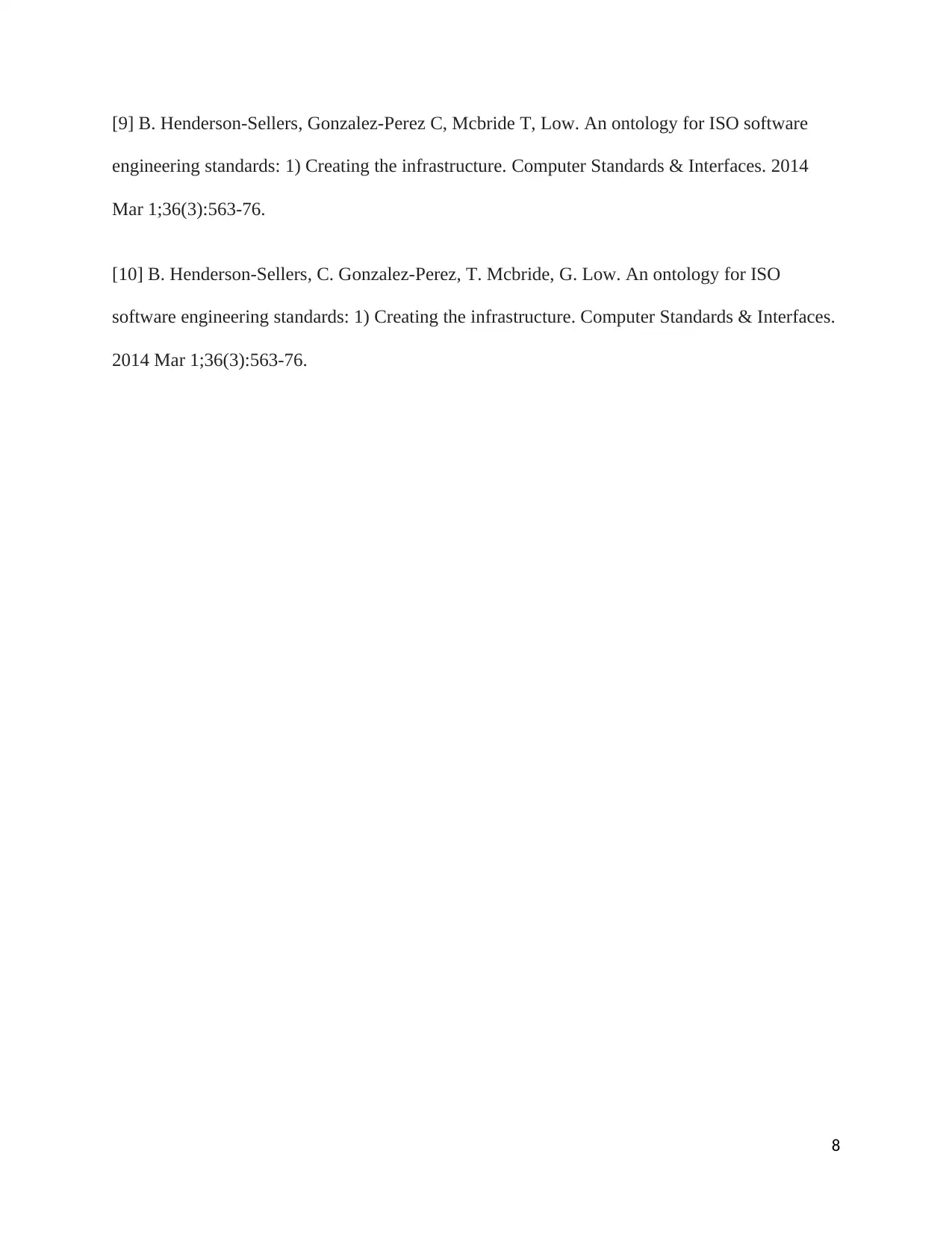
[9] B. Henderson-Sellers, Gonzalez-Perez C, Mcbride T, Low. An ontology for ISO software
engineering standards: 1) Creating the infrastructure. Computer Standards & Interfaces. 2014
Mar 1;36(3):563-76.
[10] B. Henderson-Sellers, C. Gonzalez-Perez, T. Mcbride, G. Low. An ontology for ISO
software engineering standards: 1) Creating the infrastructure. Computer Standards & Interfaces.
2014 Mar 1;36(3):563-76.
8
engineering standards: 1) Creating the infrastructure. Computer Standards & Interfaces. 2014
Mar 1;36(3):563-76.
[10] B. Henderson-Sellers, C. Gonzalez-Perez, T. Mcbride, G. Low. An ontology for ISO
software engineering standards: 1) Creating the infrastructure. Computer Standards & Interfaces.
2014 Mar 1;36(3):563-76.
8
1 out of 8
Related Documents
Your All-in-One AI-Powered Toolkit for Academic Success.
+13062052269
info@desklib.com
Available 24*7 on WhatsApp / Email
![[object Object]](/_next/static/media/star-bottom.7253800d.svg)
Unlock your academic potential
Copyright © 2020–2025 A2Z Services. All Rights Reserved. Developed and managed by ZUCOL.





